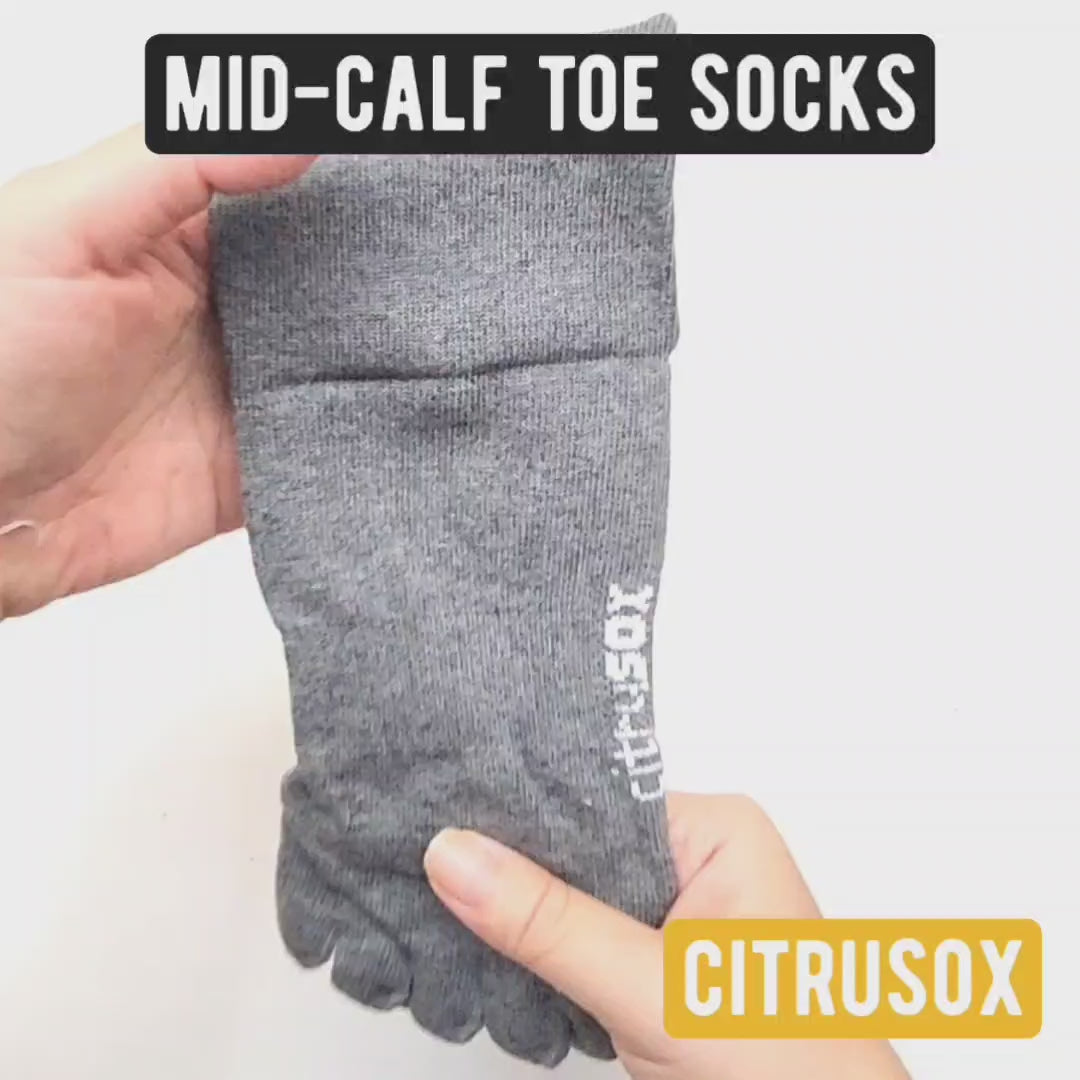The Best Socks for Cold Floors at Home
Is the cold floor at home making your feet icy every time you step onto it? And do you always have to change into another pair of socks just to keep your feet warm? At Citrusox, we know nothing feels quite like slipping your feet into soft, cozy socks to keep them warm and relaxed. Whether you love cotton socks for everyday wear or wool socks for extra warmth, finding the best socks for cold floors in Singapore can make all the difference.
What Are the Best Socks for Cold Floors at Home?
The best socks for cold floors are those that combine warmth, softness, and breathability. Cotton socks and wool socks are two popular choices, each offering different benefits depending on your home’s temperature and flooring type.
-
Cotton socks provide comfort and absorb moisture, making them suitable for everyday indoor wear.
-
Wool socks offer thicker insulation, keeping feet warm even on the coldest surfaces.
-
Leg warmers can be layered with socks to cover the calves and provide extra warmth.
The goal is to choose quality socks that feel cozy without overheating your feet.
Are Cotton Socks Good for Cold Floors?
Yes, cotton socks are great for light insulation on moderately cold floors. They’re breathable, soft, and ideal for homes in Singapore where the weather is often warm but indoor floors stay cool.
Cotton socks help regulate temperature while keeping your feet dry, especially in air-conditioned environments. They’re comfortable for daily use and one of the best socks to wear at home if you prefer a lighter feel.
Are Wool Socks Better for Warmth?
Absolutely. Wool socks are the top choice for cold floors because they naturally retain heat while wicking away moisture. Unlike cotton socks, wool fibers trap air between layers, creating insulation that keeps your feet warm even in cooler indoor conditions.
Wool socks are also durable and resist odors, making them one of the best socks in Singapore for anyone who wants reliable warmth and long-lasting comfort.
Can I Wear Leg Warmers with Socks at Home?
Yes, pairing leg warmers with socks is an effective way to add extra insulation, especially if you have tile or marble floors. Leg warmers cover your calves and ankles, which helps prevent heat loss and keeps your legs warm in air-conditioned rooms.
They’re perfect for combining cotton socks or wool socks, creating a cozy layer of warmth from your toes to your knees.
Why Do Floors in Singapore Feel Cold Even in a Tropical Climate?
Even though Singapore has a warm climate, most homes have tiled or marble floors that retain coolness. In addition, the frequent use of air conditioning lowers indoor temperatures, making floors feel cold to bare feet.
Wearing socks in Singapore, especially wool socks or quality cotton socks, helps create a barrier between your feet and the cold surface, reducing discomfort and improving circulation.
What Type of Socks Material Is Best for Indoor Comfort?
When choosing the best socks for indoor comfort, consider these materials:
-
Cotton socks – soft, breathable, and good for everyday wear.
-
Wool socks – thicker, warmer, and excellent for insulation.
-
Blended socks – combine cotton or wool with synthetic fibers for elasticity and durability.
High-quality materials ensure your socks stay comfortable and long-lasting, even after frequent washing.
How Can I Choose Quality Socks in Singapore?
When selecting quality socks in Singapore, look for:
-
Fabric density – thicker socks for cold floors, lighter ones for daily comfort.
-
Fit – snug but not tight, allowing good airflow.
-
Elastic cuffs – prevent slipping without cutting circulation.
-
Breathable weaves – keep your feet dry and fresh.
These features make a noticeable difference in warmth and comfort, especially if you walk barefoot on cold tiles often.
How Do I Care for My Cotton and Wool Socks?
Proper care extends the life of your cotton socks and wool socks.
-
Wash cotton socks in cold or lukewarm water to maintain elasticity.
-
For wool socks, use mild detergent and air dry to prevent shrinking.
-
Avoid harsh chemicals or fabric softeners that weaken fibers.
Clean, well-maintained socks feel softer, last longer, and continue to provide warmth and comfort at home.
Do Socks Really Make a Difference for Foot Health?
Yes. Wearing socks regularly on cold floors protects your feet from temperature shocks and dryness. They also improve blood circulation by maintaining warmth, which helps prevent stiffness and discomfort.
Both cotton socks and wool socks can help maintain good foot hygiene by absorbing moisture and reducing the risk of fungal infections, making them essential for overall foot care.
What Are the Most Popular Types of Socks in Singapore Homes?
In Singapore, cotton socks, wool socks, and leg warmers are commonly used for indoor comfort. Many prefer cotton socks for their softness and breathability, while wool socks are chosen during colder months or for extra comfort in air-conditioned spaces.
Each serves a different need, but all provide the same benefit, warm, cozy feet on cold floors.
Why Choose Citrusox?
At Citrusox, we focus on creating quality socks that blend comfort, durability, and thoughtful design for everyday living. Our collection of cotton socks, wool socks, and leg warmers is made to suit Singapore’s unique climate, keeping your feet cozy on cold floors while staying breathable in warm weather. With attention to detail and a commitment to using premium materials, we ensure that every pair offers the right balance of warmth and softness for your home. Choosing Citrusox means choosing comfort, reliability, and socks that truly care for your feet.
Conclusion
The best socks for cold floors at home provide warmth, comfort, and breathability. Whether you prefer cotton socks, wool socks, or leg warmers, the right pair can make your home feel cozier and your feet more comfortable every day.
At Citrusox, we craft quality socks designed for everyday comfort in Singapore’s climate. If you are looking for the best socks for cold floors, reach out to us and find the perfect pair to keep your feet warm and relaxed!
FAQs
The best socks for cold weather are wool socks and cotton socks designed with insulating materials to trap warmth. Wool socks are particularly effective because they retain heat and wick away moisture, keeping feet warm and dry.
Wool socks, especially those made from merino wool, are the warmest type of socks for cold floors and chilly environments. Their natural fibers create excellent insulation while remaining breathable for comfort.
The sock trick involves wearing cotton socks or wool socks layered to maintain warmth and promote circulation. Some people even wear slightly damp cotton socks under dry wool socks overnight to boost circulation and relieve cold symptoms.
Wool is the best material for cold feet because it naturally insulates while wicking away moisture. Wool socks provide lasting warmth and softness, unlike synthetic materials that can trap sweat.
Wool socks are often better than thermal socks because they balance warmth and breathability. While thermal socks trap heat, wool socks regulate temperature and keep feet comfortable longer.
Your feet may still feel cold with thermal socks if circulation is poor or if your socks are too tight. Moisture buildup can also make your feet feel cold, so it’s best to wear breathable wool socks instead.
The healthiest material for socks is organic cotton or merino wool, as they are breathable and gentle on the skin. These materials prevent odor and moisture buildup, keeping your feet fresh and comfortable.
Yes, 100% merino wool keeps you warm because of its natural insulation and temperature-regulating properties. It traps body heat effectively without causing overheating.
The main disadvantage of merino wool socks is their higher cost compared to synthetic ones. They can also be less durable if not properly cared for, requiring gentle washing and air drying.
You can increase the warmth in your feet by wearing thick wool socks and keeping them dry at all times. Layering socks or using slippers with good insulation can also help maintain cozy warmth on cold floors.















